I am building an optical pickup using a photodiode connected to a LM741 op-amp. My circuit is similar to this one:

Except that I've added a passive high-pass filter after the output of the op-amp, to eliminate DC (since I am using 0V and +12V as my V- and V+, respectively). I use Rf=500K Ohm (is this way too much?). In addition, I have an LED adjacent to the photodiode that serves as a light source. The LED is powered by 5V and the op-amp is powered by 12V, both from a PC power supply. The photodiode and LED are connected to the circuit using a 2m long guitar cable ("PL").
The circuit works and produces audio signal when I modulate the intensity of the light shining on the photodiode, but my problem is that the signal is very noisy. I can hear/see two types of noise:
- Electrical noise similar to a noisy electric guitar pickup. I suspect that it originates in the long cable (or the tip of it, where the photodiode and the LED are conected) collecting ambient electromagnetic noise. This noise is present all the time, even when no light is shining on the photodiode.
- Another noise is present only when a signal is generated, i.e only when I modulate the light intensity. I suspect it is a result of amplifying thermal noise, since my gain is very high.
I would like to know what is the best approach, or in other words where to start in my effort to eliminate the noise:
- Improving the signal to noise ratio at the source, i.e by optimizing the physical conditions (ambient light, precision of the position of the photodiode, etc.).
- Using a different circuit - I've seen many suggestions on the web and started with the simplest.
- Using a different op-amp, one that is more suitable as an audio pre-amplifier.
- Improving the shielding of the pickup itself, to eliminate electromagnetic ambient noise.
- Using batteries as power source instead of the PC power supply (I am thinking maybe part of the noise is coming form the mains).
- If none of the above, What would be your suggestion?